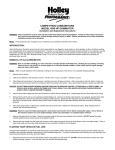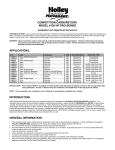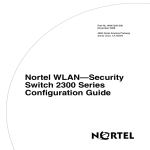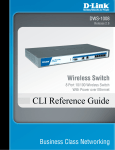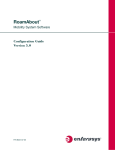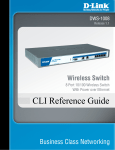Download competition carburetors gen 3 model 4500 ultra dominator series
Transcript
COMPETITION CARBURETORS GEN 3 MODEL 4500 ULTRA DOMINATOR SERIES Installation and Adjustment Instructions P/N 199R10652-1 CONGRATULATIONS on your purchase of Holley ULTRA Dominator Series carburetor! We feel that you have purchased the finest performance carburetor manufactured today. Should you need information or parts assistance, please contact our Technical Service Department at 1-866-464-6553 or 1-270-781-9741, Monday through Friday, 8 a.m. to 5 p.m. CST. Please have the part number of the product you purchased on hand when you call. WARNING! These instructions must be read and fully understood before beginning installation. Failure to follow these instructions may result in poor performance, vehicle damage, personal injury, or death. If these instructions are not fully understood, installation should not be attempted. INTRODUCTION: Holley Performance Products has written this instruction sheet for the installation of the Model 4500 ULTRA DOMINATOR Series carburetors. This instruction sheet contains all the information needed to install these carburetors. Please read all the WARNINGS and NOTES, as they contain valuable information that can save you time and money. Holley Performance Products cannot and will not be responsible for any alleged or actual engine or other damage, or other conditions resulting from misapplication of the carburetor described herein. However, it is our intent to provide the best possible products for our customer; products that perform properly and satisfy your expectations. NOTE: These carburetors are not designed to pass any emissions laws. They are to be used only for competition use/offroad vehicles or vehicles that are not required to comply with any exhaust emissions standards. GENERAL INFORMATION: This instruction sheet cannot contain all of the information, which may be desired by some individuals. Further clarification is available in HOLLEY CARBURETORS (P/N 36-73), published by H.P. books and available at your Holley distributor. An in-line fuel filter should be installed between the fuel pump and the carburetor. Recommended fuel pressure should be set at 7-1/2 psi maximum; 5 psi minimum. Fuel pressures above 7-1/2 psi can create severe fuel control problems and are not recommended. Fuel lines should be a minimum of 3/8”. A non-restrictive open-element air cleaner kit is recommended. Secondary jet extensions are included with most Holley Ultra Dominators. New or modified fuel lines are required (if replacing existing Holley Dominator 4500 series carburetor - previous bowl machining was 7/8-20, Aluminum Ultra Dominator carburetors come assembled with -6AN to SAE 8 port fittings). Holley P/N 34-48 34-49 34-50 26-143-1 26-143-2 List of Available Holley & Earl’s Fuel Lines & Adapters Earl’s P/N Description AT105296ERL -8AN Dual Feed Ano-Tuff w/ Pro-Lite 350 Hose 105286ERL -8AN Dual Feed Red & Blue w/ Stainless Hose -8AN Dual Feed Ano-Tuff w/ Stainless Hose -8AN to SAE 8 port fittings (Black) -8AN to SAE 8 port fittings (Red) REMOVAL OF OLD CARBURETOR: WARNING! Prior to and after installing your new carburetor, manually operate the throttle lever, checking for any sticking or binding. Failure to do so may result in a runaway engine or a wide open throttle condition, which could result in engine damage personal injury, and/or death. NOTE: Make a visual inspection of the carburetor, looking for any missing parts, bent levers, or any possible shipping damage. 1. Remove the air cleaner or scoop assembly. 2. Carefully disconnect all hoses and lines. When removing the fuel line, slide a rubber cap plug over the end to prevent fuel from running out, which may create a fire hazard. Use a clean metal container to collect any spilled fuel. DANGER! DO NOT SMOKE WHEN WORKING AROUND GASOLINE OR GASOLINE VAPORS. EXTINGUISH ALL OPEN FLAMES. AN OPEN FLAME, SPARK, AND/OR EXTREME HEAT COULD RESULT IN A FIRE AND/OR EXPLOSION CAUSING SERIOUS INJURY, DEATH, AND/OR PROPERTY DAMAGE. 3. Remove the throttle linkage and automatic transmission controls (if applicable) from the throttle lever. Disassemble and save the throttle return spring. 4. Remove the two front and two rear-attaching manifold flange nuts. Remove the throttle cable bracket, if so equipped (located at the left rear-attaching bolt). Remove the carburetor by lifting it straight upward. Sometimes the carburetor can stick to the manifold gasket, requiring it to be pried loose. Before prying, double check to make sure all the carburetor attaching bolts and connections have been removed. 5. Place clean shop towels or rags into the manifold opening to prevent dirt or debris from entering the engine. Keep exposed ends of fuel lines free from dirt. WARNING! Failure to cover the intake opening with a clean towel could result in dirt or debris entering the engine. Dirt or debris in the induction system can cause engine damage, which may necessitate in a complete engine overhaul. 6. Remove the gasket from the intake. Remove any gasket material that may have adhered to the manifold. DO NOT gouge the intake manifold sealing surface during removal of old gasket material. 7. Remove the shop towels from the intake and vacuum out the intake channel to ensure no dirt or debris is left in the intake system. Place a clean shop towel over the entire intake opening until you are ready to install the new carburetor. FLUSHING YOUR VEHICLE’S FUEL LINE: During fuel line installation, be careful to avoid introducing any dirt particles that could enter the fuel inlet and jam open the needle and seat resulting in carburetor flooding, malfunctioning, and/or possible engine fire. In all cases where the fuel line has been cut, it is essential that it be cleaned to prevent contamination from entering your new carburetor. The fuel line must be flushed of ru st, dirt, and other debris. DANGER! Holley DOES NOT recommend the procedure where the coil wire is disconnected, the engine cranked for a few revolutions, and the fuel is collected in a container. This procedure is unsafe, because sparking can occur either at the coil, or at the distributor end of the coil wire, which may ignite any fuel spilled in the engine compartment. This could cause an EXPLOSION or FIRE, which may result in serious injury or death! WARNING! Flush fuel lines only in a well-ventilated area and away from all sources of heat or flame. Failure to follow these instructions may cause gasoline vapors to ignite resulting in a fire or explosion, which may result in serious injury or death. WARNING! Wear eye protection when performing this step. Failure to wear eye protection can result in gasoline or other contaminates entering the eye, which could result in permanent eye damage or blindness. 1. Disconnect the fuel line at the fuel pump. 2. Using a compressed air source, blow the fuel line clean collecting any discharged fuel in an approved metal or plastic container. 2 INSTALLATION OF NEW CARBURETOR: WARNING! Holley Performance Products highly recommends that a quality fuel filter be installed with any replacement carburetor to catch any dirt that may still remain in the system. Any dirt that may enter the carburetor can cause the carburetor to flood or malfunction. A carburetor that has a malfunction caused by dirt in the system due to negligence of the owner will void the warranty. 1. Install a flange gasket on the manifold. If a spacer is being used the order will be flange gasket, spacer, and another flange gasket over the manifold stud bolts. WARNING! The carburetor should be installed directly onto its manifold without an adapter whenever possible. Sometimes an adapter can create problems with hood clearance, airflow, throttle linkage, fuel line attachment, and/or fuel mixture distribution. However, if an adapter is required, one is available through your Holley distributor under P/N 17-9, which adapts the Model 4500 to AFB- Holley square flange manifolds. Adapter height is 2-1/4 inches. Operate the linkage to ensure correct travel by fully opening and closing the throttle by hand, as well as with the accelerator pedal (with engine off). 2. Place the carburetor in position over the four stud bolts and secure in place. Tighten in a criss cross pattern to 60 in-lbs. Be careful not to over-tighten the nuts. WARNING! Over-tightening the carburetor manifold flange hold-down nuts may result in a warped or cracked carburetor throttle body. The carburetor hold-down nuts should be tightened down progressively in a criss-cross pattern to 60 in./lbs., so that vacuum leaks are prevented and to avoid causing damage to the throttle body. A carburetor that has been damaged due to negligence of the owner will void the warranty. NOTE: Existing fuel line must be modified or a new fuel line must be installed due to increased center-center distance on the fuel bowl inlets. This carburetor is supplied with -6AN fuel inlet fittings. The inlet machining for the Aluminum fuel bowls is SAE -8 port straight o-ring (¾”-16). 3. Connect the fuel lines, throttle linkage, and return springs. Operate linkage to assure correct travel by fully opening and closing the throttle by hand. STARTING: 1. For the mechanical fuel pump, remove the positive wire from the ignition coil (do not let this wire touch anything to prevent a short during cranking or KOEO [key on engine off]). Crank the engine over for 10 seconds to allow fuel bowls to fill. Reconnect the coil positive wire when finished. Electric fuel pumps let the fuel bowls fill in stages by turning the ignition on and then off. Let the fuel pump run for a few seconds at a time. If an oil pressure safety switch is being used, the customer will need to temporarily bypass the switch. WARNING! DO NOT crank the engine for more than 15 seconds at a time. Cranking longer than 15 seconds can overheat the starter, resulting in premature starter failure. 2. After starting the engine, check fuel lines and inlet fittings for possible fuel leaks. WARNING! If any fuel leakage or weeping is detected, shut off the engine immediately, and wipe up any fuel. Locate the source of the leak and correct before proceeding any further. TUNING AND ADJUSTMENT: Before you begin to tune your carburetor for your particular vehicle, you must get a “FEEL” for your vehicle’s performance, so that any changes you make (Good or Bad) will be readily apparent. Be patient and make only one change at a time, so that only that change can be fully analyzed. This cannot be overemphasized, as there are no “short-cuts” to peak performance. Recording each change and the resulting performance increase or decrease will provide you with a “Handbook” of how vehicle performance is affected by individual carburetor adjustments. This may be helpful in the future or on other applications. FUEL LEVEL (FLOAT LEVEL) FOR ULTRA DOMINATOR SERIES: The floats control the fuel delivery. However, if the float(s) is not properly adjusted, a fuel starvation or a flooding affect could result. This operation is difficult to do accurately on a rough-idling vehicle. 1. 2. Start the vehicle. The fuel level in the clear sight glass should be mid-level to slightly below center for correct float adjustment. Depending on the type of fuel used, float level may or may not need to be adjusted. See Figure 1 and 1a. 3 Figure 1 Figure 1a 3. If you do need to adjust this, loosen the lock screw and turn the adjusting nut clockwise to lower the fuel level and counterclockwise to raise the fuel level. Adjust the needle and seat only one flat of the nut at a time so you do not get the float to far out of adjustment. Use caution when making adjustments. Fuel will be under pressure and may leak out if lock screw is loosened excessively. 4. Tighten the lock screw while holding the adjustment nut. Make sure the fuel level is mid-level to slightly below center of the sight glass. 5. If necessary, flush the bowl by revving the engine a few times with the transmission in neutral. TIP: To lower the fuel in the secondary bowl manually, open the secondary throttle shaft slightly. This will allow the secondary side to supply fuel to the engine and drop the fuel level faster. IDLE SPEED ADJUSTMENTS: NOTE: Please read the following paragraph carefully before proceeding with idle speed adjustments. Your new Holley Aluminum Ultra DOMINATOR carburetor has been set up from the factory with optimized throttle plate positioning in relation to the transfer slots. If after installing the carburetor, you find the idle speed needs adjusting, it is recommended to adjust the idle speed utilizing the new Idle Bypass Valve. If the proper idle speed cannot be achieved using the Idle Bypass Valve, the curb idle screw(s) can then be adjusted. 4 IDLE BYPASS VALVE: Fully Open Midway Closed Fully Closed The idle bypass valve allows for additional airflow through the carburetor, while maintaining the desired relationship between the throttle plate and the transfer slot. Applications using a larger cam may benefit most from this new feature. This valve replaces the need for holes in the throttle plates. 1. Use the Holley screwdriver provided to finely tune your idle bypass circuit. This is a reversible screwdriver and you may need to flip it to the straight bit side. 2. The valve must be adjusted without the air cleaner stud in place. Insert driver down through stud hole and into slot on valve. 3. Turn clockwise to close off the idle bypass valve. This moves the valve down in the passage and begins to block the holes in the main body, therefore reducing idle RPM. Turning the valve counter-clockwise will increase airflow through the bypass valve, continue to adjust valve to obtain the desired engine idle RPM. 4. To see the position of the idle bypass valve, look in the drilled hole passages in the air cleaner boss on the main body. IDLE SPEED SCREW: The idle speed screw controls the throttle plate position at idle, which in turn raises or lowers the engine rpm. Here are the proper steps for setting the engine’s idle speed. 1. Start the engine and allow it to warm up. 2. Connect a tachometer, if your vehicle is not equipped with one. 3. Make sure the parking brake is on (if equipped), and the wheels are blocked. Place the automatic transmission in drive or the manual transmission in neutral. 4. After adjusting the idle bypass screw, if the idle speed is lower than desired, turn the screw clockwise to speed up the rpm. If the idle speed is higher than desired, turn the idle screw counter-clockwise to lower the rpm. This adjustment should be made to both the primary and secondary screws in equal amounts, so that the throttle plates are opened the same amount. 5 Figure 2 Figure 3 Figure 4 IDLE MIXTURE SCREWS: Your carburetor will have four idle mixture screws; one for each venturi. This is known as four-corner idle. If you change one idle mixture screw, you should change the other idle mixture screws the same amount. Here are the proper steps for setting the idle mixture screws. 1. First get the engine up to temperature. 2. With the engine off, install a vacuum gauge on a full manifold vacuum port. If a full manifold vacuum port is unavailable, you may tune to the highest idle RPM utilizing a tachometer. 3. Next, screw the idle mixture screws in all the way and then back them out ¾ of a turn. 4. Restart the engine (with the engine up to temp and @ idle) and adjust a mixture screw out 1/8 turn at a time. 5. Continue to adjust each idle mixture screw the same amount to achieve the highest possible vacuum reading or RPM without increasing the idle speed screw. 6. Now that the idle mixture is set, it may be necessary to go back and reset the idle speed using the idle speed screw. Continue back and forth between the tuning of the idle mixture screws and idle speed screws, until little change is noticed in manifold vacuum or RPM and desired idle speed is achieved. NOTE: 6 Turning the mixture screws IN decreases the idle mixture, while turning them OUT increases the idle mixture. ACCELERATOR PUMP: The accelerator pump’s purpose is to make up for the lag in fuel delivery. This enables the engine speed to increase in resp onse to throttle opening. Differences in vehicle weight, transmissions, and rear axle ratios affect the amount of fuel and the delivery rate that should be provided by the accelerator pump. This may necessitate the customizing of your accelerator pump to your vehicle and its use. NOTE: The old saying, “If a little is good, a lot is better,” does not apply to the proper tuning of the accelerator pump. Your car’s performance can be just as bad if it receives “too much fuel too soon,” as if it receives “too little fuel too late.” Two factors that affect the accelerator pump’s delivery are the pump cam and the pump shooter (discharge nozzle). The pump cam determines the total volume of fuel and affects delivery rate. The pump shooter affects delivery rate and helps determine the duration of the shot. There are two pump cams, which can be purchased separately. Holley P/N 20-80 has two operating locations and Holley P/N 20-81 has one operating location. This provides for several distinct delivery rates. The 20-80 pump cam is designed to give a quick early shot of fuel, but it does not empty the pump. The 20-81 pump cam design delivers an early fuel shot and continues, until the pump empties. Changing the location of the pump cam screw from the #1 hole to the #2 hole will increase the ramp speed of the cam. Conversely, going from the #2 to the #1 hole will slow the ramp speed. The pump shooters have a number stamped on their casting, which designates the shooter size in thousandths of an inch, i.e., a #25 shooter has a .025” discharge orifice. The smaller diameter nozzles lengthen the pump shot duration and are used with heavier vehicles or with vehicles equipped with lower numerical rear axle ratios. Larger diameter nozzles (.035 - .037) shorten the pump shot duration, but deliver a greater initial volume of fuel. These sizes should be used on applications where engine speed will increase rapidly (vehicles with good power-to-weight ratios). Best acceleration is achieved when the accelerator pump delivers the lean best power air/fuel ratio to the engine; not when the maximum volume of fuel is supplied. Keep in mind when tuning an ULTRA DOMINATOR, the secondary accelerator pump must supply fuel for a sufficient time, so that the secondary main nozzles can “start up” and deliver fuel to the engine after the secondary throttles are opened. If the nozzles do not start by the time the pump shot expires, bogging will result. To apply the information above, follow these steps for tuning the accelerator pump. Figure 5 Figure 6 Figure 7 1. Change the pump shooters, until the smallest diameter nozzle, which provides the crispest response is found. 2. Then change the pump cams and locations, until the right cam is found that provides even more response. 3. Finally, change the pump shooter once again, until the crisp response is maximized. 7 NOTE: If a nozzle size is desired that seems “in between” the nozzle sizes provided, then the nozzle can be drilled to the desired size by using a wire drill held in a pin vise. 4. At this point, there should be no bogs, flat spots, or black smoke (indicating excessive richness) when accelerating at wide-open throttle from a standing start. ADJUSTABLE LINKAGE: The external linkage on the Ultra Dominator is adjustable for Soft progressive, intermediate progressive, progressive, and 1 to 1 throttle actuation. From Holley, the link is set-up for progressive throttle activation. The chart below details what hole in the linkage is used for the various actuations along with the approximate dimensions for the adjustable link. If adjustment is desired, please follow the steps below: 1. Remove the two cotter pins. Then, remove the washers making sure not to mix them up as they will need to go back in the same place. 2. Remove the secondary link. 3. Hold the primary and secondary throttle shaft to wide open throttle. Adjust the link to the proper length so it fits easily into the proper hole on the primary shaft and into the secondary shaft. 4. Re-install the washers and secure the cotter pins. 5. Cycle the throttle several times to ensure it is going to wide open throttle and to a fully closed position without binding or sticking, If the throttle does not go to full open or closed position, adjustments to the length of the link may be necessary. Figure 8 ADJUSTABLE LINKAGE CHART: Desired Actuation Hole # Dimension Soft Progressive Intermediate Progressive Progressive 1 to 1 1 2 3 4 1.60” 1.70” 1.80” 2.00” JETTING (MAIN JETS): Due to varied applications that a universal performance carburetor will work with, no additional tuning jets have been included. However, a few tips on jetting are provided to help you understand their purpose. NOTE: This carburetor is equipped with drain plugs on both bowls to make jet changes quicker and easier. Please use appropriate fuel collection device and procedures. 1. Out of the box jetting is extremely close for most applications. 2. In most cases, it will be unnecessary to increase jet size more than four numbers greater than out of the box jetting. However, exceptions could arise when the carburetor is mounted on a very large volume, plenum-ram manifold. 8 3. Carburetors are calibrated at 70° at sea level. Decrease the jet size one number (approx. .002”) for approximately every 2000 ft. increase in altitude. Increase jet size one number for every 35° drop in temperature. 4. Holley jets are broached, flowed, and stamped according to flow rate. Never drill jets, this seriously alters flow characteristics. Stamped numbers are reference flow numbers and DO NOT indicate drill size. 5. Spark plugs provide the best indication of proper jetting. SECONDARY MAIN JET EXTENSIONS: Main jet extensions are used in secondary metering block assemblies to prevent the secondary main jets from being uncovered as fuel rushes to the back of the fuel bowl during extreme accelerations. Most Holley Ultra Dominators come equipped with jet extensions. Additional jet extension kits specifically for the Holley bowl are available (Holley P/N 122-5002). POWER VALVES: The number on a power valve, such as 65 (two numbers clockwise from the letter are the size), indicates the manifold vacuum below which the power valve is operational. In this case, all manifold vacuums below 6.5” Hg., the power valve is operating. Generally, a 55 power valve is sufficient for most high performance applications that have a manifold vacuum of 12” Hg or higher. If the engine has a manifold vacuum of 12” Hg or less, a good way to determine power valve size is take the manifold vacuum at idle and divide that number by two. The answer is the power valve size. This will provide proper fuel flow under wide-open throttle conditions when manifold vacuums seldom rise above 1” Hg. NOTE: Gen III Dominators come equipped from the factory with plugs in the secondary metering block. TUNABLE METERING BLOCK: IMPORTANT! It is recommended that you document the existing adjustable bleed sizes that make up this metering block BEFORE any changes are made. This billet adjustable metering block allows the user to tune the intermediate circuit restrictions (on 3-circuit carburetor), idle feed restrictions, emulsion bleed restrictions, and to the power valve and main jets. IMPORTANT! Holley highly recommends that only an experienced carburetor tuner [with access to a dynamometer that monitors air/fuel ratio and BSFC (Brake Specific Fuel Consumption)] make any changes to the factory restrictor settings, as received from Holley. Furthermore, Holley is not responsible for any engine damage that may occur due to the carburetor being changed from the original factory calibration. Intermediate Circuit Feed Restrictions: Inclusion of this circuit was required as a means of obtaining a smooth transition from the idle to the main metering system. It is intended to overcome a dip in the fuel delivery curve of the Model 4500 carburetor. Increasing/decreasing restrictor size delivers more/less fuel to enrich/lean the mixture for transition. 3 Circuit Billet Metering Block (Back) Model 4500 Ultra DOMINATOR Figure 9 9 Power Valve Channel Restrictions (PVCR): These two restrictions are visible when the power valve is removed. They meter the flow of additional fuel into the main well. It is the PVCR diameter, not the openings in the power valve, which controls the amount of fuel admitted in the circuit. Changing the size of these restrictions will lean/enrich the air/fuel ratio at full power, but will have no effect at idle or during part throttle operation, when the power valve is closed. Idle Feed Restrictions (IFR): The idle circuit calibration is determined by the diameter of the IFR and the idle air bleed. An IFR is nothing more than a metering jet for the idle system and the air bleed serves as an air/flow-regulating orifice. Turning the idle mixture screw varies the volume of air/fuel emulsion discharged into the manifold, not the ratio of air to fuel in the emulsion. Typically, as camshaft duration and overlap are increased, idle fuel jetting (idle feed restriction size) must be correspondingly increased to compensate for dilution and scavenging (where an amount of intake charge is drawn out through a late closing exhaust valve). 3 Circuit Billet Metering Block (Front) Model 4500 Ultra DOMINATOR Figure 10 Emulsion Bleeds: The emulsion bleeds are best tuned on the dynamometer. Bleed utilization (size and location) can vary, as will horsepower gains, depending upon the engine. Not all of the emulsion bleed holes have to be used to obtain peak performance. Gains have been documented on use of as little as three (one side of metering block) of the bleed holes. NOTE: The emulsion bleed tuning kit (P/N 36-322) will support tuning of this metering block. It contains ten each of the following bleed sizes: Blank (no hole), .020”, .031”, .040”, .046”, and .052”. Individual bleeds are available from blanks to .082” from your Holley dealer under individual P/Ns 142-xx (xx=size). AIR BLEEDS: Experimenting with air bleeds is not recommended and should only be attempted by an expert carburetor tuner. Countless hours of testing have been performed to obtain the proper bleed size for a given calibration. It is unlikely that a better air bleed calibration can be obtained, however the 4500 ULTRA DOMINATORS are equipped with removable air bleeds. Here is some basic knowledge of how air bleeds work. The main or high-speed air bleeds affect the entire range of the main-metering system. The purpose of the main metering system and main air bleeds is to emulsify the fuel before entering the booster and eventually being discharged into the air stream of the venturi. The fuel/air mixture becomes leaner as air bleed size is increased. Decreasing the size of the main air bleeds will increase pressure across the main jet, which in turn will pull more fuel through the main system creating a richer fuel/air mixture. The main or high-speed air bleeds also act as an anti-siphon or siphon breaker, so fuel does not continue to discharge or dribble into the venturi after airflow is reduced or stopped. At high speeds, the fuel/air mixture must be on the rich side to prevent damage to the engine. The idle system supplies fuel at idle and low speeds. The idle system requires a richer mixture than at cruise speed. Unless the idle mixture is richer, a slow and irregular combustion will occur know as a rough idle. Decreasing the idle air bleed size richens the idle mixture by increasing the pressure drop in the system. Increasing idle air bleed size leans the idle mixture by reducing the pressure drop across the idle air bleeds. The same conditions can be created by backing out the idle mixture screws, which will increase the 10 pressure across the idle air bleeds, pushing more fuel from the idle well creating a richer fuel/air ratio. The idle mixture screw is the only adjustment recommended for controlling the idle fuel/air mixture richness or leanness. The intermediate system is designed to provide extra fuel between idle and the main system operation. As the throttle is opened past the idle transfer slot, the manifold vacuum that was being applied to the idle system is greatly reduced. Air flow is not sufficient enough to start the main system. The intermediate system fills this gap, eliminating any flat spots in transition from idle to wide-open throttle. One thing to note about the intermediate system is that it will continue to operate even at wide-open throttle. This must be considered when tuning the main jets. Since the intermediate system is activated by pressure, changing the air bleeds will adjust the richness of the fuel/air mixture. Decreasing the intermediate air bleed size richens the intermediate mixture by increasing the pressure drop in the system. Increasing the intermediate air bleed size leans the intermediate mixture by reducing the pressure drop across the intermediate feed restrictions. WARNING! ADJUSTMENT OF THE AIR BLEEDS IS NOT RECOMMENDED. ONLY A COMPETENT MECHANIC WITH A COMPLETE AND THOROUGH KNOWLEDGE OF CARBURETORS, FUEL SYSTEM, AND ENGINE REQUIREMENTS SHOULD PERFORM AIR BLEED ADJUSTMENTS. FAILURE TO FOLLOW THESE RECOMMENDATIONS MAY RESULT IN A LEAN ENGINE CAUSING SEVERE ENGINE DAMAGE, PROPERTY DAMAGE, SERIOUS INJURY, AND/OR DEATH. WARNING! AIR BLEED SIZES SHOULD NOT BE ADJUSTED MORE THAN SIX (6) SIZES IN ANY ONE DIRECTION FROM THE ORIGINAL AIR BLEEDS, AS SHIPPED FROM HOLLEY. AIR BLEED ADJUSTMENT BEYOND SIX (6) SIZES COULD RESULT IN A LEAN ENGINE, CAUSING SEVERE ENGINE DAMAGE, PROPERTY DAMAGE, SERIOUS INJURY, AND/OR DEATH. Figure 11 NOTE: See Figure 11 for air bleed locations and identification. It is recommended that all jet sizes be documented before any tuning of the air bleeds or main jets is started. Below is a chart for recording the jet and air bleed sizes for your 4500 ULTRA DOMINATOR carburetor, as shipped from Holley. Should you adjust the air bleed size or main jet size, this chart will allow the tuner to return the carburetor to the original jetting. Please place this information in a safe place along with any other documentation for your carburetor. 11 IFR IntFR (if applicable) PVCR POWER VALVE EMULSION BLEEDS: BLEED 1 BLEED 2 BLEED 3 BLEED 4 BLEED 5 JET IAB IntAB (if applicable) HSB SQUIRTER Holley Technical Support Toll-Free: 1-866-464-6553 Phone: 1-270-781-9741 Fax: 1-270-781-9772 For online help, please refer to the Tech Service section of our website: www.holley.com © 2013 Holley Performance Products, Inc. All rights reserved. 199R10652-1 Revision Date: 10-24-14 12















